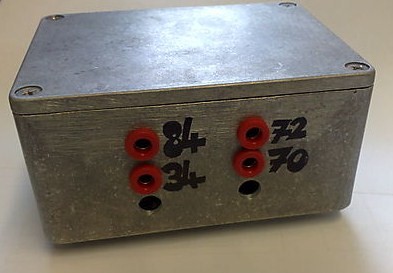
Return to main page
Background for beginners
What I did last summer
Skills and Experiences
More info (for experts/collaborators)
What's next?
Philippa Young
Designing an Analogue Low Pass Filter System for a Quantum Ion Trap.
My Role in the Project
- 6 Filters for simple trapping:

The initial ion trap consists of 6 electrodes, each of which will have a voltage applied to trap the ion. This meant that for trapping the first ion the filter system would need to consist of 6 low pass filters, one for each of the pins on the D connectors which leads to an electrode.
Detailed descriptions of the steps involved in manufacturing this filter can be seen on the following pages:
Researching and specifications,
Designing and parts sourcing,
Manufacturing,
Testing.100 Filters for shuttling:
After an ion has been trapped the group can go onto a process called shuttling the ion. This is a more complex procedure and so the specifications for the filter system will have changed. The filter system will need to have a filter on every available pin, which is approximately 100 filters (there are 100 pins but some are blank and some go to ground)
The process of designing this second filter system can be seen on the following pages:
Researching and specifications,
Simulating filters,
Designing the PCB and sourcing parts,
Manufacturing,
Testing.
- 399nm:
At the beginning of my placement I was working on the 399nm laser. This involved mounting the diode - making sure the ellipse is horizontal - and ensuring the pins were correctly wired.
The next step was to mount the collimating lens. This is done by adjusting the placement of the lens and looking at the beam across a large distance to ensure the beam is of a uniform cross section. Then the lens is glued to the base.
The next step to set up the laser was to attach the diffraction grating. The grating is placed in the path of the laser so that the laser hits the center of the grating. This can then be glued to an adjustable mount. To achieve feedback the grating angle is changed until the zeroth order of light is reflected back into the diode and the first order becomes noticeably brighter.
The feedback can be maximised by very small adjustments of the angle of the diffraction grating using the fine adjustment screws and observing the intensity of the beam as the current is stepped down to the threshold.
Unfortunately the diffraction grating we were using became damaged and when the specification was looked at we discovered that the efficiency was not suitable for our wavelength. This meant I had to look into different diffraction gratings and find one which met our requirements better. I had a quote for a suitable grating from Newport, however it would take 4 to 6 weeks for delivery so this was ordered and I moved onto the filter system for the rest of the summer.
- Minimising noise:
In order to have a laser diode stabilised and with minimal noise it must be running at a stable temperature. To make sure our lasers were properly thermally insulated I helped cut foam which then enclosed the entire laser casing on all four sides and the top. Judging by the wavemeter output this has improved the signal of the diodes and reduced noise quite considerably.
-
Many of the tasks on the vacuum system are very delicate and fiddly. This meant that when difficult tasks were carried out (such as wiring up the D-connectors to the trap chip bracket and attaching various sections of the system) assistance was needed.
After being told about the contamination procedures (wearing gloves, a boiler suit and face mask to ensure everything was clean) I assisted in a range of jobs, from measuring capacitances to checking the connections on the chip bracket and tightening the bolts holding the pieces together.
The next task would have been to attach the viewing windows, however the torque wrench was causing the heads of the bolts to degenerate and bolts were snapping, so this had to be looked into before we could proceed.
-
In order to half of the lab laser safe, the blackout curtain needed modification as the curtain was only about 6 foot tall, and so lasers could possibly escape from the table over the curtain.
In order to block the top section as well, a separate piece of black out curtain was hung above the main curtain. I had to measure and cut holes to accommodate the air conditioning vents and fix rivets into the top of the curtain so that I could hang it from a copper pipe which had been installed along the ceiling. The edges could then be taped to the vents and the walls at the sides so there were no gaps where light could escape.
This means that one half of our lab is a laser safe area so people can use the computers or work at the table without needing to wear protective goggles.